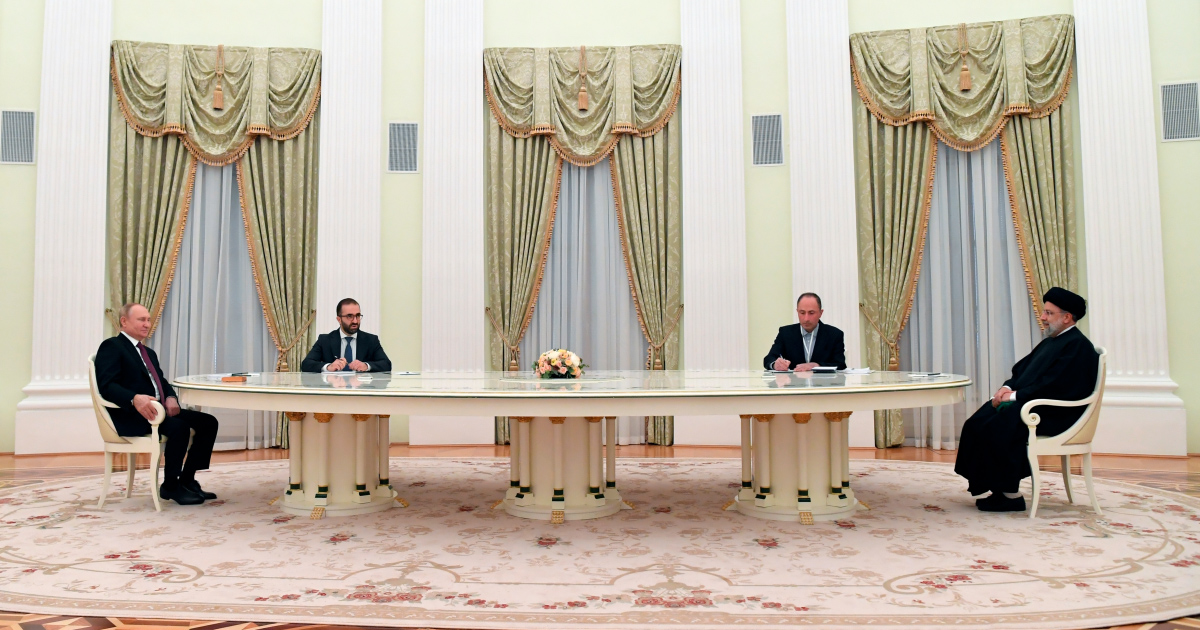Kourosh Ziabari – Asia Times: When Iranian President Ebrahim Raisi recently posed for a photo-op with his Russian counterpart Vladimir Putin, the top-level meeting in Moscow was trumpeted by state media as a bilateral “turning point,” “new chapter” and even “diplomatic triumph.”
But a closer examination of the optics suggests something unspoken is still diplomatically amiss. Critical observers of the January 19 meeting noted that Raisi’s arrival at the Kremlin was not received by a guard of honor befitting his status as a foreign leader.
In the meeting room, the two countries’ flags were not placed, which the same observers noted is a rarity for Putin’s meetings with heads of government and even a possible breach of diplomatic protocol. Nor was a joint press conference held after the meeting, which was held at a long table physically separating the leaders and lasted for only 15 minutes.
In their public meeting, Putin hailed Iran’s contributions to the Shanghai Cooperation Organization (SCO) political, economic and security alliance as “an observer,” belying Iranian media and government-affiliated pundits who claim Iran was recently admitted to the China-led bloc as a permanent member.
The SCO, a key body in Russia and China’s drive to counter the US in the region, still refers to Iran as an “observer” member on its official website. Its secretariat in Beijing didn’t respond to a request by Asia Times for clarification on whether recent reports about the change of Iran’s status were accurate.
More significantly, Putin explicitly asked Raisi to share his views about the restoration of the Joint Comprehensive Plan of Action (JCPOA) nuclear deal, which Russia favors. Raisi reportedly dodged the question, saying only that the Islamic Republic is trying to “neutralize” the effects of US sanctions.
Raisi’s trip was initiated at Putin’s invitation. Iranian state media and Raisi’s publicity team had initially hyped it as an “official visit,” but when Russia’s preparations to welcome him were scaled back, they revised it to a “working visit.”
Previous Iranian president Hassan Rouhani visited Russia four times during his 8-year tenure. His foreign minister Javad Zarif said in an interview that he visited Russia 33 times during his ministerial mandate, and is known to have cultivated close working relations with his counterpart Sergey Lavrov.
Raisi, whose anti-Western rhetoric and ultra-conservative ideology have put relations with Europe and the United States on a new edge, has made it clear that his foreign policy vision prioritizes ties with neighbors and scaling up partnerships with Russia and China.
Although Raisi’s administration is currently in negotiations to restore the JCPOA, a holdover of the Rouhani era, it doesn’t seem sanguine about its revival and restored relations with the West, which is why cozying up to Russia and China is on the top of his government’s agenda.
Relations with Russia date back to 1521 and over the centuries have been marked by drastic ups and downs. Some Iranians recall with bitterness how Russia campaigned for large swaths of Iran’s territory in the north to be split from the country between 1813 and 1828, when the Treaty of Gulistan and Treaty of Turkmenchay were signed.
That’s underscored certain nationalistic perceptions that Russia has historically treated Iran with contempt and as a colony. Nowadays, however, the Islamic Republic prefers to soft-pedal the nation’s unpleasant past with Russia, which it now relies on for its security and as an economic lifeline in times of crisis.

